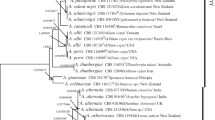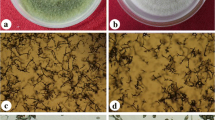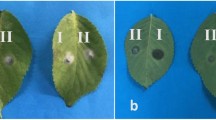Abstract
Sunflower (Helianthus annuus L.) is an important oilseed crop in South Africa, and is grown in rotation with maize in some parts of North West, Limpopo, Free State, Mpumalanga and Gauteng provinces. Alternaria leaf blight is currently one of the major potential disease threats of sunflower and is capable of causing yield losses in all production regions. Alternaria helianthi was reported as the main cause of Alternaria leaf blight of sunflower in South Africa; however small-spored Alternaria species have been consistently isolated from leaf blight symptoms during recent surveys. The aim of this study was to use morphological and molecular techniques to identify the causal agent(s) of Alternaria blight isolated from South African sunflower production areas. Alternaria helianthi was not recovered from any of the sunflower lesions or seeds, with only Alternaria alternata retrieved from the symptomatic tissue. Molecular identification based on a combined phylogenetic dataset using the partial internal transcribed spacer regions, RNA polymerase second largest subunit, glyceraldehyde-3-phosphate dehydrogenase, translation elongation factor and Alternaria allergen gene regions was done to support the morphological identification based on the three-dimensional sporulation patterns of Alternaria. Furthermore, this study aimed at evaluating the pathogenicity of the recovered Alternaria isolates and their potential as causal agents of Alternaria leaf blight of sunflower. Pathogenicity tests showed that all the Alternaria alternata isolates tested were capable of causing Alternaria leaf blight of sunflower as seen in the field. This is the first report of A. alternata causing leaf blight of sunflower in South Africa.



Similar content being viewed by others
References
Allen, S. J., Brown, J. F., & Kockman, J. K. (1983). Effect of leaf age, host growth stage, leaf injury and pollen on the infection of sunflower by Alternaria helianthi. Phytopathology, 73, 896–898.
Andersen, B., Kroger, E., & Roberts, G. (2002). Chemical and morphological segregation of Alternaria arborescens, A. infectoria and A. tenuissima species-groups. Mycological Research, 106(2), 170–182.
Andrew, M., Peever, T. L., & Pryor, B. M. (2009). An extended multilocus phylogeny does not resolve morphological species with the small-spored Alternaria species complex. Mycologia, 101(1), 95–109.
Aradhya, M. K., Chan, H. M., & Parfitt, D. E. (2001). Genetic variability in the pistachio late blight fungus, Alternaria alternata. Mycological Research, 5(3), 300–306.
Ausubel, F. M., Brent, R., Kingston, R. E., Moore, D. D., Seidman, J. G., Smith, J. A., & Struhl, K. (1998). Short protocols in molecular biology. New Jersey: Wiley.
Calvet, N. P., Ungaro, M. R. G., & Oliveira, R. F. (2005). Virtual lesion of Alternaria blight on sunflower. Helia, 28(42), 89–100.
Fairchild, K. L., Miles, T. D., & Wharton, P. S. (2013). Assessing the fungicide resistance in populations of Alternaria in Idaho potato fields. Crop Protection, 49, 31–39.
Hall, T.A. (1999). BioEdit: A user-friendly biological sequence alignment editor and analysis program for windows 95/98/NT. Nucleic Acids Symposium Series, 41, 95–98.
Kapsa, J.S. & Osowski, J. (2012). Host – pathogen interaction between Alternaria species and S. tuberosum under different conditions. Thirteenth Euroblight workshop: St. Petersburg, Russia. Special Report, 15, 107–112.
Konstantinova, P., Bonants, P. J. M., Gent-Pelzer, M. P. E., Zouwen, P., & Bulk, R. (2002). Development of specific primers for detection and identification of Alternaria spp. in carrot material by PCR comparison with blotter and plating assays. Mycological Research, 106(1), 23–32.
Kumar, V., Haldar, S., Pandey, K. K., Singh, R. P., Singh, A. K., & Singh, P. C. (2008). Cultural, morphological, pathogenic and molecular variability amongst tomato isolate of Alternaria solani in India. World Journal of Microbiology and Biotechnology, 24, 1003–1009.
Kusaba, M., & Tsuge, T. (1995). Phylogeny of Alternaria fungi known to produce host-specific toxins on the basis on the variation in the internal transcribed spaces of the ribosomal DNA. Current Genetics, 28, 491–498.
Lapagodi, A. L., & Thanassoulopoulos, C. C. (1998). Effect of a leaf spot disease caused by Alternaria alternata on sunflower yield in Greece. Plant Disease, 82, 41–44.
Lawrence, D. P., Gannibal, P. B., Peever, T. L., & Pryor, B. M. (2013). The sections of Alternaria: formalising species-groups concepts. Mycologia, 105(3), 530–546.
Logrieco, A., Moretti, A., & Solfrizzo, M. (2009). Alternaria toxins and plant diseases: an overview of origin, occurrence and risks. World Mycotoxin Journal, 2(2), 129–140.
Lourenco Jr., V., Moya, A., Gonzalez-Candelas, F., Carbone, I., Maffia, L. A., & Mizubuti, E. S. G. (2009). Molecular diversity and evolutionary processes of Alternaria solani in Brazil inferred using genealogical and coalescent approaches. Phytopathology, 99, 765–774.
Meng, J. W., Zhu, W., He, M. H., Wu, E. J., Duan, G. H., Xie, Y. K., Jin, Y. J., Yang, L. N., Shang, L. P., & Zhan, J. (2015). Population genetic analysis reveals cryptic sex in the phytopathogenic fungus Alternata alternata. Scientific Reports, 5, 18250.
Nishikawa, J., & Nakashima, C. (2013). Taxonomic characterization and experimental host ranges of four newly recorded species of Alternaria from Japan. Journal of Phytopathology, 161, 604–616.
Park, M. S., Romanoski, C. E., & Pryor, B. M. (2008). A re-examination of the phylogenetic relationship between the causal agents of carrot black rot, Alternaria radicina and A. carotiincultae. Mycologia, 100(3), 511–527.
Peever, T. L., Su, G., Carpenter-Boggs, L., & Timmer, L. W. (2004). Molecular systematic of citrus-associated Alternaria species. Mycologia, 96(1), 119–134.
Peever, T. L., Carpenter-Boggs, L., Timmer, L. W., Carris, L. M., & Bhatia, A. (2005). Citrus black rot is caused by phylogenetically distinct lineages of Alternaria alternata. Phytopathology, 95, 512–518.
Pryor, B. M., & Gilbertson, R. L. (2000). Molecular phylogenetic relationships amongst Alternaria species and related fungi based upon analysis of nuclear ITS and mt SSU rDNA sequences. Mycological Research, 104(11), 1312–1321.
Pryor, B. M., & Michailides, T. J. (2002). Morphological, pathogenic, and molecular characterization of Alternaria isolates associated with Alternaria late blight of pistachio. Phytopathology, 92, 406–416.
Rotem, J. (1994). The genus Alternaria: Biology, epidemiology and pathogenicity. APS Press: St Paul.
SAS Institute Inc. (2013). Base SAS® 9.4 procedures guide: Statistical procedures. Cary: SAS Institute Inc..
Simmons, E.G. (2007). Alternaria: An identification manual. CBS Biodiversity 6, CBS Fungal Biodiversity Centre, Utrecht, The Netherlands.
Stammler, G., Bohme, F., Philippi, J., Miessner, S., & Tegge, V. (2014). Pathogenicity of Alternaria species on potatoes and tomatoes. Fourteenth EuroBlight Workshop: Limassol, Cyprus. Special Report, 16, 85–96.
Swofford, D. L. (2002). PAUP*. Phylogenetic analysis using parsimony (*and other methods). Version 4. Sinauer Associates. Sunderland, Massachusetts.
Thomma, B. P. H. J. (2003). Alternaria spp.: From general saprophytic to specific parasite. Molecular Plant Pathology, 4(4), 225–236.
van der Westhuizen, G. C. A., & Holtzhausen, M. A. (1980). Alternaria helianthi on sunflower in South Africa. Phytopathologica, 12, 49–52.
Woudenberg, J. H. C., Groenewald, J. Z., & Crous, P. W. (2013). Alternaria redefined. Studies in Mycology, 75(1), 171–212.
Woudenberg, J. H. C., Seidi, M. F., Groenewald, J. Z., de Vries, M., Stielow, J. B., Thomma, B. P. H. J., & Crous, P. W. (2015a). Alternaria section Alternaria: Species, formae speciales or pathotypes? Studies in Mycology, 82, 1–21.
Woudenberg, J. H. C., van der Merwe, N. A., Jurjevic, Z., Groenewald, J. Z., & Crous, P. W. (2015b). Diversity and movement of indoor Alternaria alternata across the mainland USA. Fungal Genetics and Biology, 81, 62–72.
Zhu, X. Q., & Xiao, C. L. (2015). Phylogenetic, morphological and pathogenic characterization of Alternaria species associated with fruit rot of blueberry in California. Phytopathology, 105, 1555–1567.
Funding
This study was funded by The Oil- and Protein Seeds Development Trust, South Africa.
Author information
Authors and Affiliations
Corresponding author
Ethics declarations
The research presented in this research does not implicate nor Human Participants and/or Animals.
Conflict of interest
The authors declare that they have no conflict of interest.
Rights and permissions
About this article
Cite this article
Kgatle, M.G., Truter, M., Ramusi, T.M. et al. Alternaria alternata, the causal agent of leaf blight of sunflower in South Africa. Eur J Plant Pathol 151, 677–688 (2018). https://doi.org/10.1007/s10658-017-1402-7
Accepted:
Published:
Issue Date:
DOI: https://doi.org/10.1007/s10658-017-1402-7




